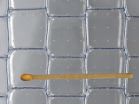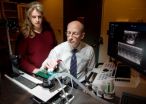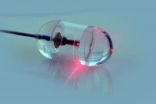(Press-News.org) Parkinson's experts across the world have been reporting a remarkable phenomenon — many patients treated with drugs to increase the activity of dopamine in the brain as a therapy for motor symptoms such as tremors and muscle rigidity are developing new creative talents, including painting, sculpting, writing, and more.
Prof. Rivka Inzelberg of Tel Aviv University's Sackler Faculty of Medicine first noticed the trend in her own Sheba Medical Center clinic when the usual holiday presents from patients — typically chocolates or similar gifts — took a surprising turn. "Instead, patients starting bringing us art they had made themselves," she says.
Inspired by the discovery, Prof. Inzelberg sought out evidence of this rise in creativity in current medical literature. Bringing together case studies from around the world, she examined the details of each patient to uncover a common underlying factor — all were being treated with either synthetic precursors of dopamine or dopamine receptor agonists, which increase the amount of dopamine activity in the brain by stimulating receptors. Her report will be published in the journal Behavioral Neuroscience.
Giving in to artistic impulse
Dopamine is involved in several neurological systems, explains Prof. Inzelberg. Its main purpose is to aid in the transmission of motor commands, which is why a lack of dopamine in Parkinson's patients is associated with tremors and a difficulty in coordinating their movements.
But it's also involved in the brain's "reward system" — the satisfaction or happiness we experience from an accomplishment. This is the system which Prof. Inzelberg predicts is associated with increasing creativity. Dopamine and artistry have long been connected, she points out, citing the example of the Vincent Van Gogh, who suffered from psychosis. It's possible that his creativity was the result of this psychosis, thought to be caused by a spontaneous spiking of dopamine levels in the brain.
There are seemingly no limits to the types of artistic work for which patients develop talents, observes Prof. Inzelberg. Cases include an architect who began to draw and paint human figures after treatment, and a patient who, after treatment, became a prize-winning poet though he had never been involved in the arts before.
It's possible that these patients are expressing latent talents they never had the courage to demonstrate before, she suggests. Dopamine-inducing therapies are also connected to a loss of impulse control, and sometimes result in behaviors like excessive gambling or obsessional hobbies. An increase in artistic drive could be linked to this lowering of inhibitions, allowing patients to embrace their creativity. Some patients have even reported a connection between their artistic sensibilities and medication dose, noting that they feel they can create more freely when the dose is higher.
Therapeutic value
Prof. Inzelberg believes that such artistic expressions have promising therapeutic potential, both psychologically and physiologically. Her patients report being happier when they are busy with their art, and have noted that motor handicaps can lessen significantly. One such patient is usually wheelchair-bound or dependent on a walker, but creates intricate wooden sculptures that have been displayed in galleries. External stimuli can sometimes bypass motor issues and foster normal movement, she explains. Similar types of art therapy are already used for dementia and stroke patients to help mitigate the loss of verbal communication skills, for example.
The next step is to try to characterize those patients who become more creative through treatment through comparing them to patients who do not experience a growth in artistic output. "We want to screen patients under treatment for creativity and impulsivity to see if we can identify what is unique in those who do become more creative," says Prof. Inzelberg. She also believes that such research could provide valuable insights into creativity in healthy populations, too.
INFORMATION:
American Friends of Tel Aviv University (www.aftau.org) supports Israel's leading, most comprehensive and most sought-after center of higher learning. Independently ranked 94th among the world's top universities for the impact of its research, TAU's innovations and discoveries are cited more often by the global scientific community than all but 10 other universities.
Internationally recognized for the scope and groundbreaking nature of its research and scholarship, Tel Aviv University consistently produces work with profound implications for the future.
Parkinson's treatment can trigger creativity
Patients treated with dopamine-enhancing drugs are developing artistic talents, reports a Tel Aviv University researcher
2013-01-14
ELSE PRESS RELEASES FROM THIS DATE:
Team finds gene that promotes drug resistance in cancer
2013-01-14
Scientists from the University of Iowa and Brigham Young University (BYU) have identified a gene that may be a target for overcoming drug resistance in cancer. The finding could not only improve prognostic and diagnostic tools for evaluating cancer and monitoring patients' response to treatment but also could lead to new therapies directed at eradicating drug-resistant cancer cells.
Drug resistance is a common problem in many metastatic cancers. It leads to failure of chemotherapy treatments and is associated with poor patient outcomes, including rapid relapse and death.
The ...
American College of Physicians calls for immunizations for all health care providers
2013-01-14
PHILADELPHIA, January 14, 2013 -- The American College of Physicians (ACP) has approved a policy recommendation that all health care providers (HCPs) be immunized against influenza; diphtheria; hepatitis B; measles, mumps, and rubella; pertussis (whooping cough); and varicella (chickenpox) according to the Advisory Committee on Immunization Practices (ACIP) Adult Immunization Schedule. ACP's policy exempts HCPs for medical reasons or a religious objection to immunization.
"These transmissible infectious diseases represent a threat to health care providers and the patients ...
Are some patients too heavy for a new kidney?
2013-01-14
ST. LOUIS – In a research review article published in the American Journal of Nephrology, Saint Louis University investigators examined data from multiple studies to better understand how obesity, an epidemic in the U.S., impacts kidney transplant patients. The authors report that, even as some connections between weight and health outcomes are unknown or contradictory, there is evidence that obese kidney transplant patients don't do as well after surgery, experiencing more adverse outcomes, including wound infections, delayed graft function, graft failure, cardiac disease ...
Noise protection – multifunctional and aesthetical
2013-01-14
Too much noise causes illness. This is as an undisputed fact nowadays, and yet we're still constantly assailed by noise as we go about our daily lives, be it from traffic or voices in large open-plan offices. Noise pollution can be reduced with the help of structural solutions; we've all seen noise barriers along busy roads and train lines, and there are special acoustic structural components, so-called sound absorbers, which are used inside buildings to keep noise levels down. But there's a problem. The construction components used up until now may well be effective at ...
Can acupuncture improve exercise performance and post-exercise recovery?
2013-01-14
New Rochelle, NY, January 14, 2013—The effects of acute acupuncture applied during exercise on performance factors such as power and blood pressure and on the body's ability to recover post-exercise were evaluated in a review article published in The Journal of Alternative and Complementary Medicine, a peer-reviewed journal from Mary Ann Liebert, Inc., publishers. The article is available free on the Journal website at http://www.liebertpub.com/acm.
A review of the literature uncovered four studies designed to test whether a person receiving acupuncture while exercising ...
Stem-cell approach shows promise for Duchenne muscular dystrophy
2013-01-14
CHAMPAIGN, Ill. — Researchers have shown that transplanting stem cells derived from normal mouse blood vessels into the hearts of mice that model the pathology associated with Duchenne muscular dystrophy (DMD) prevents the decrease in heart function associated with DMD.
Their findings appear in the journal Stem Cells Translational Medicine.
Duchenne muscular dystrophy is a genetic disorder caused by a mutation in the gene for dystrophin, a protein that anchors muscle cells in place when they contract. Without dystrophin, muscle contractions tear cell membranes, leading ...
Social networks may inflate self-esteem, reduce self-control
2013-01-14
PITTSBURGH/NEW YORK—January 14, 2013— Users of Facebook and other social networks should beware of allowing their self-esteem—boosted by "likes" or positive comments from close friends—to influence their behavior: It could reduce their self-control both on and offline, according to an academic paper by researchers at the University of Pittsburgh and Columbia Business School that has recently been published online in the Journal of Consumer Research.
Titled "Are Close Friends the Enemy? Online Social Networks, Self-Esteem, and Self-Control," the research paper demonstrates ...
Fox Chase researchers discover novel role of the NEDD9 gene in early stages of breast cancer
2013-01-14
PHILADELPHIA, PA (January 14, 2013)—Breast cancer is the second leading cause of cancer deaths among women in the United States. Many of these deaths occur when there is an initial diagnosis of invasive or metastatic disease. A protein called NEDD9—which regulates cell migration, division and survival—has been linked to tumor invasion and metastasis in a variety of cancers. Researchers at Fox Chase Cancer Center have now shown that NEDD9 plays a surprising role in the early stages of breast tumor development by controlling the growth of progenitor cells that give rise to ...
Pill-sized device provides rapid, detailed imaging of esophageal lining
2013-01-14
Physicians may soon have a new way to screen patients for Barrett's esophagus, a precancerous condition usually caused by chronic exposure to stomach acid. Researchers at the Wellman Center for Photomedicine at Massachusetts General Hospital (MGH) have developed an imaging system enclosed in a capsule about the size of a multivitamin pill that creates detailed, microscopic images of the esophageal wall. The system has several advantages over traditional endoscopy.
"This system gives us a convenient way to screen for Barrett's that doesn't require patient sedation, a ...
The secrets of a tadpole's tail and the implications for human healing
2013-01-14
Scientists at The University of Manchester have made a surprising finding after studying how tadpoles re-grow their tails which could have big implications for research into human healing and regeneration.
It is generally appreciated that frogs and salamanders have remarkable regenerative capacities, in contrast to mammals, including humans. For example, if a tadpole loses its tail a new one will regenerate within a week. For several years Professor Enrique Amaya and his team at The Healing Foundation Centre in the Faculty of Life Sciences have been trying to better understand ...
LAST 30 PRESS RELEASES:
Researchers identify gene that calms the mind and improves attention in mice
Artificial metabolism turns waste CO2 into useful chemicals
Ancient sea anemone sheds light on animal cell type evolution
Begging gene leads to drone food
How climate policies that incentivize and penalize can drive the clean energy transition
Can community awareness campaigns in low-resource areas improve early diagnosis of colorectal cancer?
Stardust study resets how life’s atoms spread through space
Practical education: Clinical scenario-based program development
The impact of family dynamics on eating behaviour – how going home for Christmas can change how you eat
Tracing the quick synthesis of an industrially important catalyst
New software sheds light on cancer’s hidden genetic networks
UT Health San Antonio awarded $3 million in CPRIT grants to bolster cancer research and prevention efforts in South Texas
Third symposium spotlights global challenge of new contaminants in China’s fight against pollution
From straw to soil harmony: International team reveals how biochar supercharges carbon-smart farming
Myeloma: How AI is redrawing the map of cancer care
Manhattan E. Charurat, Ph.D., MHS invested as the Homer and Martha Gudelsky Distinguished Professor in Medicine at the University of Maryland School of Medicine
Insilico Medicine’s Pharma.AI Q4 Winter Launch Recap: Revolutionizing drug discovery with cutting-edge AI innovations, accelerating the path to pharmaceutical superintelligence
Nanoplastics have diet-dependent impacts on digestive system health
Brain neuron death occurs throughout life and increases with age, a natural human protein drug may halt neuron death in Alzheimer’s disease
SPIE and CLP announce the recipients of the 2025 Advanced Photonics Young Innovator Award
Lessons from the Caldor Fire’s Christmas Valley ‘Miracle’
Ant societies rose by trading individual protection for collective power
Research reveals how ancient viral DNA shapes early embryonic development
A molecular gatekeeper that controls protein synthesis
New ‘cloaking device’ concept to shield sensitive tech from magnetic fields
Researchers show impact of mountain building and climate change on alpine biodiversity
Study models the transition from Neanderthals to modern humans in Europe
University of Phoenix College of Doctoral Studies releases white paper on AI-driven skilling to reduce burnout and restore worker autonomy
AIs fail at the game of visual “telephone”
The levers for a sustainable food system
[Press-News.org] Parkinson's treatment can trigger creativityPatients treated with dopamine-enhancing drugs are developing artistic talents, reports a Tel Aviv University researcher




